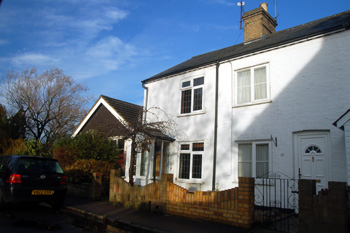
10 and 12 Link Way November 2009
The Rating and Valuation Act 1925 specified [Section 19 (1)] that every piece of land and property in the country be valued to determine the rateable value. Clifton, like most of Bedfordshire, was assessed in 1927 and the valuer visiting 12 Link Way [DV1/C207/75-76] noted that the house was owned by J. West and leased by Charles Harwood who paid £12 per annum in rent. The brick and slate house was the end of a terrace of six and had been two cottages but was now used as one. It comprised a parlour, living room, kitchen and scullery downstairs with four bedrooms and a boxroom above. One room was used as an office. Water was laid on to the premises, which was not surprising, given that Harwood also ran a mineral water factory.
The valuer described the factory as both owned and occupied by Charles Harwood and comprised the following range of buildings: a corrugated iron loading shed measuring 20 feet by 12 feet; a wood and tile bottle store measuring 20 feet 3 inches by 18 feet 6 inches; a brick and tile mineral water factory measuring 40 feet by 17 feet. The factory was run by a steam plant in an attached engine house. Average output was a twelve hundred bottles per annum, or between four and five per day. An office led out of the factory and had a store cupboard. The valuer commented: "Poor, mixed up old place".
Local historian Barry Livesey prepared some notes on Clifton's mineral water factory for Bedfordshire and Luton Archives and Records Service in May 1985 [CRT130Cli18]: "George Harwood was born in Shefford in 1840 and probably moved to Clifton shortly after his marriage in about 1865".
"At the time of the 1871 census he and his family lived in Ibbutt Cottages, probably in what is now 12 Link Way, where he worked as a shoe repairer and his wife Mary plaited straw. During the next few years he set up in business as a Ginger Beer Manufacturer and in the census of 1881 he and his sons Charles aged 16 and William aged 14 were all involved in the business. Alfred Harwood aged 7 and Annie aged 4 lived with their parents but for some reason George Junior aged 11 and James aged 10 boarded with Mr. and Mrs. Roberts, an elderly couple".
"This was the heyday of the developing carbonated water business and there were literally hundreds of patents covering bottle designs that maintained the pressure of carbon dioxide gas and gave drinks their fizzyness".
"For some reason Charles and William left the business and it was George and Alfred who took over when their father died in 1899. The business then assumed its best known trading title of G. & A. Harwood and it maintained this for the rest of its existence, even though Alfred went off on his own and set up a mineral water works at Staines in Middlesex".
"By the turn of the century the factory was well established opposite the pond with George Harwood junior living with his family in the White House, having moved from "Elthorne" in Shefford Road. By present day standards the factory was relatively primitive but by the standards of the time it was sophisticated, using high pressure bottle filling machines capable of filling 80 dozen bottles per hour".
"The range of products sounds mouth-watering:
- Brewed Stone Ginger Beer;
- Lime Juice and Soda;
- Lemonade;
- Cherry Cider;
- Hop Ale;
- Ginger Ale"
"The work was very seasonal with the peak demand during the summer and just before Christmas. The factory stove was lit at 7 a.m. and work started an hour later. Bottles returned to the factory had to be washed and the labels removed before being re-filled and taken back to the pubs and shops of Clifton, Shefford, Henlow, Bedford, Holwell, Pirton, Shillington, Stotfold and Arlesey".
"The factory had a staff of five or six including a foreman, a delivery man and three or four women. Clifton villagers in the '20's and '30's all knew the words of a song about the works sung to the tune of the hymn "The Head That Once was Crowned With Thorns": "Tastic makes the Ginger Beer, Ikie takes it round. Professor lays the stoppers out and Harriet screws them down". Tastic was Frank West the foreman, Ikie was Ike West the delivery man, professor was Frank Mabbot and Harriet was Harriet West".
"The factory office was situated next to the works in 12 The Link Way known then as Factory Row. George Harwood junior died in 1936 and for the next few years his son Gilbert George and his daughter Mabel took over. During this period a "crown cap" bottle filler was purchased from Ely Brewery to supplement the Codd bottle filling machine that had been bought many years before from R. White Limited. The onset of war in 1939 brought sugar rationing and the works was forced to close in 1941. It opened for a few years after the war and finally closed for good about 1947. Gilbert Harwood presented the gates at the entrance to the Church Burial Ground in Stanford Lane as a memorial to his sister Gladys".